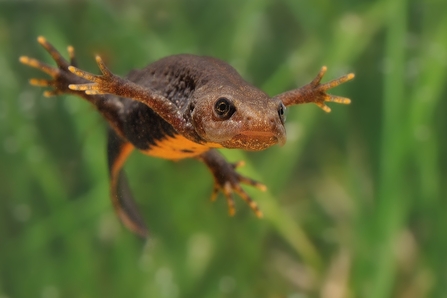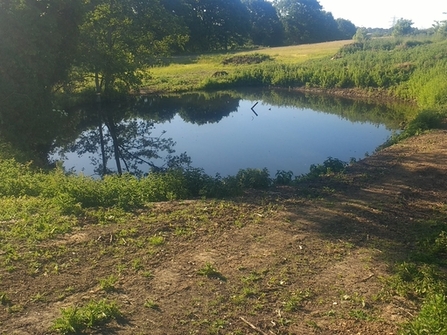This winter saw the successful creation or restoration of several more ponds across the county as Suffolk Wildlife Trust worked with farmers and landowners to deliver habitat for great crested newts where it is needed most. Suffolk Wildlife Trust is a delivery partner for the new District Level Licensing Scheme in Suffolk and have been working with farms to restore and create ponds for the last two years.
Working with farmers to restore and create farmland ponds for great crested newts
Great crested newt
Farmland pond - Mike Porter
District Level Licensing is a new approach to offsetting the impacts of development on protected great crested newt populations, with the aim of creating stronger populations in the long term. This approach involves creating ideal habitat for great crested newts within areas of the county that already have good newt populations to produce large and healthy metapopulations* of newts. This is a change to the original approach to the protection of this species, where development sites would need to be surveyed and all newts re-homed, an approach that is often not the best outcome from an ecological point of view.
Suitable breeding ponds are usually the limiting factor in maintaining good great crested newt populations, so targeting of pond restoration and creation helps create larger and more robust newt populations in the wider countryside. Each pond is looked after for a period of 25 years and the entire scheme is funded through contributions made by the developer, so any pond that is lost to development is replaced with four more.

Great crested newt - Adobestock
Creating and restoring ponds that are good for great crested newts is an interesting challenge. Each pond must hold clean water through most summers and have a good range of underwater bathymetry (lumps and bumps); gently sloping sides are needed to create a wide drawdown zone (the area at the edge of a pond that is frequently exposed to the air due to changes in water level) and good links to land habitat with hibernating opportunities is very important. Soft-leaved aquatic and emergent plants are essential for a pond to hold great crested newts as they use these for egg laying. Usually these species are quick to arrive in new ponds and even faster in restoration ponds where the seedbank, sometimes many years old, is often still viable. Ponds must have buffers from arable operations and too much livestock interest. Ponds for great crested newts should be free of fish and the attentions of large numbers of duck.

Recently restored farmland pond
Of course, all life needs water, so as well as newts, many other species in the county will benefit from this work to improve the state of our ponds. Suffolk is one of the most pond-dense counties in the country, with over 22,000 ponds. This work should mean that great crested newts are able to continue thriving in the long term and will also benefit much important wildlife. This project would not be possible without the support of the network of farms that Suffolk Wildlife Trust work with across the county, with many wildlife-friendly farmers making a great contribution to the future of the great crested newt in Suffolk.
*Metapopulation: A metapopulation consists of a group of spatially separated populations of the same species which interact at some level.
